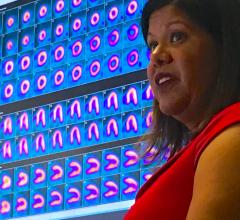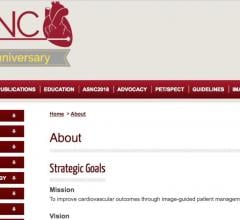
Cardiology was already heavily data driven, where clinical practice is driven by clinical study data, but mining a cardiology department's own data via the cardiovascular information system (CVIS or cardiac PACS) allows insights into a department's own patient population, best practices, workflow, physician and technologist workloads, inventory usage and patient outcomes. This data is now being leveraged to flow into a variety of clinical registries, certification programs, data mining for population health initiatives, and for the training and integration of artificial intelligence (AI) and machine learning algorithms that are starting to be adopted across the healthcare continuum.
"We need to be able to retrieve these data elements out of the medical records. But when we talk about traditional methods of data collection like transcription and paper-based documentation, it really does not allow clinicians to get this data out, so there is a need for structured reporting," said Jennifer Ireland, senior product manager, Centricity Cardio Workflow, GE Healthcare. She said structured reports need to be integrated into clinical workflows, and that clinicians need three things from these structured reports: what they saw, what they did and what is the end result, including their own conclusion or recommendation.
Structured reporting is now offered by most CVIS vendors in the U.S. market. Each system offers different levels of customization to meet a facility's data reporting needs, but it requires direct input from the physicians who will be using these systems to make them effective and gain greater buy-in from physicians who are accustomed to dictation or less structured reporting fields.
Physician Champions Aid Transition to New CVIS Platforms
CVIS vendors say the best way to make a smooth transition to a new CVIS requires a physician champion. This is a cardiologist who will head efforts to bring any issues to the attention of the the vendor. The person should be a cardiologist who is actively working with the system every day, and getting feedback from peers on how the system is working. They can help identify needs and communicate that to IT to make the changes needed to improve workflows.
An example of one such integration is the eight-hospital Methodist Healthcare San Antonio system in Texas, which recently converted to a new structured reporting CVIS system, GE Healthcare's Centricity CardioEnterprise. About 150 cardiologists use the system on a daily basis.
"We got the physician champions involved very early on to get their feedback on what sort of build we would need to do to include all the variances they are doing in the reports," explained Chad Franklin, RN, senior staff customer advocate, cardiovascular IT, GE, who helped with the Methodist go-live. "In the case of nuclear imaging, to some people that just means SPECT, but for other people that means amyloid or sarcoid PET."
Physician champions helped field questions and serve as a point person for staff to submit questions or suggestions for changes in the reports. Franklin said a champion needs to be a project team leader who is involved, not a figurehead. The hospital created sign-up sheets and asked cardiologists from various subspecialties to become potential champions and get involved with the reporting system to make sure the templates met their needs. Also, these champions were involved early on in the training so when the system went live, they acted as key trainers for each of their sections since they had the best understanding of how the software worked.
Cardiologist Randal White, M.D., was one of the physician champions at Methodist that helped with the integration of the new CVIS in the cardiac nuclear imaging. He serves American Society of Nuclear Cardiology (ASNC) committees that include IT integration elements, such as the Image Guide Registry, which promotes structured reporting as a QCDR pathway for doctors to meet CMS/MIPS quality requirements. White said Methodist performs about 10,000 nuclear imaging studies per year and he wanted to see the new system leveraged to improve efficiency.
"At the point our group became involved with structured reporting, we were experienced explosive growth, and frankly our nuclear dictations were simply unsatisfactory," White said. "Can a physician dictate a report in less time than completing a structured report? Absolutely, but when we looked at our reports prior to instituting structured reporting, data points were missing — mine included — and there was a high rate of inter- and intra-physician variability from report to report. We are now finding increased compliance with appropriate use criteria (AUC) and lower variance between intra- and inter-physician variability."
What is Needed in a Cardiology Structured Report?
He said the ASNC has guidelines on how to standardize nuclear cardiology reports, which he used a guide when working with the vendor to create the nuclear imaging reporting templates. The goal of the ASNC guidelines is to ensure structured reports can be a mechanism to improve quality outcomes and reduce costs. White explained the data from the reports is needed to allow for the transition from a volume- to value-based healthcare, and structured reporting is the vehicle to do this.
"There is a need for clarity and conciseness in our reports," White said. "You really want to be able to look at a report and get the information you need off of it within 10 seconds, and that is something we now have formatted into our reports so we can be really efficient and get our work done."
Use of standard language taxonomy is important so all the physicians using the systems are using the same apples-to-apples terms. This allows these data points to be searched later, where as multiple terms meaning the same thing are much harder to correlate. Ambiguity also needs to be removed in these reports.
"We need to avoid statements like 'clinical correlation recommended' and we need to have conclusions that explain normality versus abnormality in a study" White said. "There also should be some comment about prognosis and patient risk, and most importantly, are we answering the question posed by the referring physician."
He said the conclusion section of the reports they created include comments that act as prompts for the cardiologist. This helps draw attention to what is important in the report. There also is a need to emphasize standard data fields and make the data in a user-friendly format. This becomes very important when trying to connect a hospital's data to clinical registries, White explained. The need for better capture of structured data moving into the future is an extremely important consideration for any IT reporting systems, testing devices or imaging systems, he said.
"I don't think you can really buy an imaging device this day and age without first having a really deep conversation with the vendor about high quality structured reporting," White said. This is because data from imaging and reporting systems need to be integrated into hospital analytics software, registries and certification programs, and needs to be integrated into artificial intelligence (AI) and machine learning algorithms that are starting to be adopted across the healthcare continuum. "This data can be used for supervised and unsupervised machine learning purposes. I fully expect in the next decade these sorts of devices and concepts will be saving physicians time, while increasing accuracy and reducing inter-physician variability.
"At the point our group became involved with structured reporting, we were experiencing explosive growth, and frankly our nuclear dictations were simply unsatisfactory," he continued. "Can a physician dictate a report in less time than completing a structured report? Absolutely, but when we looked at our reports prior to instituting structured reporting, data points were missing — mine included — and there was a high rate of inter- and intra-physician variability from report to report. We are now finding increased compliance with appropriate use criteria (AUC) and lower variance between intra- and inter-physician variability."
He said adoption of structured reporting across the cardiovascular service line required numerous physician champions for each subspecialty area. White added that some "sticks and carrots" were also used as incentives to keep the clinical teams moving in the right direction so all facets of CVIS structured reporting could be instituted.
After the go-live of any CVIS, hospitals and vendors say it is important to identify any super-users early on and include them in end-to-end testing of the systems. Super-users should be given additional training so they can serve as CVIS on-site trainers for new staff moving forward.
"I think when PAMA and certifications come knocking on our door in the next year, structured reporting will be well worth our effort," White said.
Structured Data Enables Improved Business Analytics
With structured data in place, this has enabled the flow of data to enable in-depth analytics, which has become a trend in health IT over the past few years. Easy to use and immediately accessible analytics is changing how departments and hospitals are managed from a business perspective, and how they are used to track inventory, physician workflow, stats on procedures performed, and how all of these factors tie in with revenue and patient outcomes.
Related CVIS Content:


 January 05, 2023
January 05, 2023 





